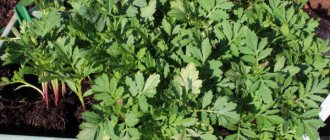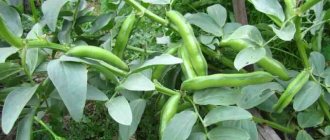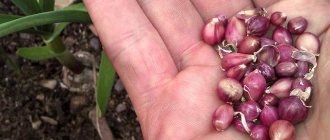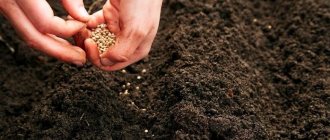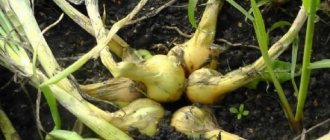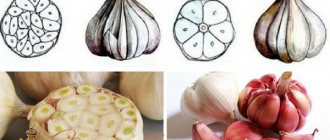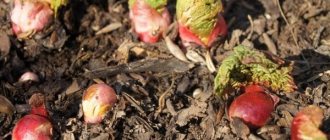Spinach is a vegetable crop that contains in its leaves a lot of useful vitamins that are essential for the functioning of the human body. Therefore, gardeners who decide to switch to a healthy diet sooner or later wonder how to plant a plant. In order for spinach planting to be successful and the bed to soon be covered with succulent rosettes, you need to know everything about the specifics of growing vegetables in the garden.
Well, then you will learn when and how to properly plant spinach in open ground in spring and autumn.
Brief description of the culture
Spinach, as a garden plant, appeared in Ancient Persia. It also received a positive assessment in the Arab world, but Europe and Russia did not immediately appreciate the plant.
Spinach is an annual crop of the goosefoot family. Its ripening lasts no more than a month. During the flowering period, green flowers are formed, from which round small fruits ripen after 90 days.
Young spinach leaves are eaten. They are dark green in color, rounded at the top. The smoothness and roughness of the leaf plate, as well as the saturation of the shade, depend on the variety of garden crop.
Spinach contains many vitamins and minerals and is rich in fiber. The amount of water in the leaves of the plant is up to 90%. During heat treatment, the quality of the composition deteriorates significantly. Therefore, it is recommended to eat it raw in salads, smoothies and other dishes.
Recommended types and varieties of spinach
The variety of spinach is divided into the following groups:
- Leaf spinach. Characterized by a green, round leaf blade. Red-brown veins may be present.
- Strawberry spinach. It differs from other varieties in that its berries, reminiscent of strawberries, are eaten. They taste like a nut-strawberry mixture. The leaves of this type of crop are small with sweet notes. They are suitable for consumption only in small doses due to the presence of toxins.
- Water spinach. A plant from the Bindweed family. The shape resembles a green onion: the leaves in a rosette have a narrow, elongated shape. Both leaves and stems are eaten. Grows in waterlogged soils, near rivers and lakes.
All varieties of spinach are divided into three types:
- early ripeness;
- medium ripeness;
- late ripeness.
When choosing seeds, be sure to take this characteristic into account and select according to your climate. Here are examples for each varietal group:
- Virofle. Suitable for planting by seed in early spring. General continuous germination appears within a month. In a lush rosette, the leaves are bright green, not large, and the stems are rigid.
- Gigantic. Shoots appear 2 weeks after sowing the seeds. The quality of the greens is excellent. In warm climates, this variety can be sown 2-3 times per season.
- Uteusha. This hybrid is characterized by frost resistance and early emergence. Spinach can be sown at the end of winter. Suitable for adding to animal and bird feed to replenish the vitamin and mineral composition in the body.
- Bloomsdelsky. Dutch variety of medium ripeness. A dense rosette consists of elongated leaves. It is afraid of cold weather, so sowing is best done in late April-early May.
- Sturdy. Mid-season frost-resistant variety. Gives a good harvest in the northern regions. Complete leaves, suitable for consumption and for preparation for storage, are obtained on the 26th-27th day.
- Fat-leaved. Late ripening variety. The rosette leaves are not particularly dense, but each of them is dense and juicy. Recommended for salad bases.
- Victoria. Late ripening spinach. Prefers warmth and high humidity. It is recommended to sow in early summer. Characterized by resistance to pest attacks and bolting.
When to Plant Strawberry Spinach Seeds
Strawberry spinach (zminda is the second name) has a number of advantages, which is why it has deservedly received the recognition of all gardeners. This unpretentious plant is very useful. In addition, the early ripening crop has an attractive decorative appearance. The leaves taste tender with a pleasant aftertaste. Even the berries of this variety are edible!
It is recommended to sow strawberry spinach directly into the soil, as the plant tolerates frost and slight temperature fluctuations. There are several times for sowing seeds of this variety:
- Early spring, late March - early April.
- Before winter, at the end of October.
In both cases, the plant will have time to grow and produce a harvest. And after harvesting, you can have time to plant any other heat-loving crop in the same area.
Timing of sowing seeds
Frost-resistant varieties of spinach can be sown in open ground in early spring at a stable temperature of 3-5 degrees Celsius. In each region, depending on the climate, these conditions coincide with the period from early March to June.
If you sow spinach at the end of summer, you can enjoy a harvest of greenery until frost. Frost-resistant seeds can be sown in winter. Having released a couple of leaves, the plant will wait out the cold season under the snow, and after it melts in the spring, it will actively begin to grow. The first harvest can be cut after 14-16 days.
According to the lunar calendar
Many gardeners take a responsible approach to the process of growing crops, and all work is carried out based on the lunar calendar, which is updated annually. It reflects the connection with gardening and the phases of the moon.
According to the lunar calendar, you can take into account only unfavorable days for landings, and adjust the rest of the time to your capabilities. This method is considered the most optimal among summer residents and gardeners. The second option is to follow the exact dates specific to planting a certain type of cultivated plant.
Days prohibited for gardening work in 2021, depending on the full moon and new moon:
- in January - 6, 21;
- in February - 5, 19;
- in March - 6, 21;
- in April - 5, 19;
- in May - 5, 19;
- in June - 3, 17;
- in July - 2, 16;
- in August - 1, 15, 30;
- in September - 14, 28;
- in October - 14, 28;
- in November - 12, 26;
- in December - 12, 26.
Varietal diversity of culture
Before you start growing spinach from seeds, you need to choose the right plant variety. When choosing a variety, pay attention to the ripening time of the crop, which is indicated on the label of the bag of seeds. Having selected seeds of different types, you can organize a conveyor collection on your site.
All varieties and hybrids are divided into early, mid-ripening and late.
- Early varieties. 15 days after germination, you can already cut off the leaves. If you sow late, the crop will start bolting early. Early ripening varieties include Matador, Ispolinsky, and Khorovod. Please note that each of them has additional qualities: Matador is resistant to low temperature and color. By the way, this is one of the highest-yielding and popular varieties. You can find out more about it on the Internet, and also order seeds. You will need to enter into the search “matador spinach growing from seeds”
- Gigantic can be grown both in open ground and protected. Does not throw out arrows for a long time, is resistant to the accumulation of nitrates.
- Round dance has a high content of vitamins.
It is worth adding that constant breeding work on developing new varieties of spinach that are low-shooting, early, resistant to powdery mildew, and produce a large mass of greenery does not stop. New items appear every year. Undoubtedly, the early ripening variety of strawberry spinach and its cultivation from seeds will arouse the interest of summer residents. In addition to juicy leaves, it produces fruits that have a strawberry aroma. The fruits are suitable for both eating and processing. Strawberry spinach is an annual plant up to 50 cm high. Fruit ovaries appear in the axils of the plant. On the fourth day after the formation of the ovaries, the fruits ripen and are ready for consumption. Moreover, growing strawberry spinach is not particularly difficult.
Preparing the site for planting
Light, non-acidified soils rich in microelements and nutrients are suitable for planting spinach. Therefore, you need to select and prepare the site responsibly:
- In autumn, remove all plant debris. They may contain fungal spores or be an overwintering site for pests. Therefore, the best option for getting rid of grass is burning.
- Dig up the area and apply fertilizer. For acidic soil, it is necessary to add chalk, ash, and limestone. During digging, you can add organic matter, such as humus. This will make the soil lighter and airier, and the flow of nutrition to the future planted crop will be gradual and long-lasting.
- If the site is located in a lowland, then it is better to build artificial beds from boards or make an embankment of fertile soil, organizing a hill for planting.
Preparatory activities on the site for autumn planting of spinach are carried out in the spring, and for spring sowing - in the fall.
What soil to plant spinach in?
The best soil for the crop is well-drained, fertile and rich in organic fertilizers. The plant will not grow in acidic soils. You can reduce acidity by adding dolomite flour or lime; the optimal pH level for it is 6.7-7.0.
Spinach will not produce high yields in carbonate and calcareous soils, since their iron levels are low. Too dense soils must be diluted with organic matter and compost.
Seed preparation
Spinach seeds can be sown in the ground without preparation, but softening their shell promotes earlier germination, and disinfection will become a preventive measure against diseases.
The following measures will help prepare seed material:
- After scattering the seeds on a flat surface, remove any damaged or deformed ones from the total mass. Ideally, there will be selection for planting the largest material.
- Place gauze, folded in several layers, on the bottom of a small plate. Scatter the seeds onto it, spreading them out in an even layer. Cover the top with a double layer of gauze and fill with water so that the seed is on a heavily moistened pad.
Leave overnight before planting, changing the water in the saucer every 4-5 hours and keeping the top gauze layer damp. In the morning, dry the seeds a little.Water for soaking seeds must be used from rain, melted water, or tap water that has settled for 24 hours.
- To disinfect seeds, place them in a light pink manganese solution for 15-20 minutes. Then rinse with running water and dry until flowability is restored.
Sow the treated seeds in the garden as soon as possible.
How to plant spinach seeds in open ground
The soil should be prepared before planting (dig up, remove weeds, and fertilize with organic matter). If this is done in advance, for example, in the fall, then spring work will be reduced. And you can sow the seeds at the first suitable conditions.
Before spring and summer sowing, it is better to soak spinach seeds for 1-2 days in water at room temperature. Every 4 hours the water must be changed to new one. Afterwards, lightly dry the seeds and sow according to the pattern corresponding to the variety: (5-6 cm) x (18-20 cm) to a depth of 1.5-2 cm for compact rosettes, 20x45 cm for large rosettes. Sowing is carried out in compacted, watered furrows.
How to sow spinach seeds in garden beds:
- Furrows are made in the soil at a distance of 15-20cm from each other.
- The soil in the furrows is well wetted.
- Seeds are sown to a depth of 2 cm and at a distance of 8 cm from each other.
If you want to get the harvest faster, you can cover the crops with film or a special cloth.
Important! This is a secondary plant that thrives in areas after peas, carrots and most cruciferous crops.
Instructions for planting spinach
Most often, spinach is grown from seeds in open ground. But it is also possible to prepare seedlings of this crop. It requires caution when transplanting, because the root system of the plant is very delicate and is easily injured. Therefore, for growing seedlings, it is recommended to use peat containers or tablets, rather than reusable containers.
Seeds
The seed planting scheme depends on the spinach variety, or more precisely on the size of the leaf rosette. Therefore, maintain the distance between seeds from 7 to 20 cm. Leave row spacing 20-40 cm wide.
Planting process:
- in the selected area, prepare furrows no more than 2 cm deep and water them well;
- arrange the seeds according to the variety and planting pattern;
- fill the furrows with soil, compacting it slightly;
- To speed up the emergence of seedlings and protect the seeds from the cold, it is recommended to cover the bed with film.
If the seeds are of high quality and properly prepared, the first shoots will appear within a week.
The following video talks about sowing spinach seeds in open ground:
Seedlings
The seedling planting method is used to obtain a faster harvest from heat-loving varieties of spinach. Seeds are sown in separate containers in February, and with the onset of a favorable period, seedlings are planted in the ground. Before planting seedlings, they must be hardened by gradually lowering the air temperature over 10-14 days.
The scheme for planting spinach seedlings suggests a distance between bushes of 20-30 cm, and a width between rows of at least 30 cm.
Technology for planting spinach seedlings:
- on the site, dig holes of such a size that a peat container with seedlings or plants with a root ball of soil can fit;
- place a unit of seedlings in the hole and sprinkle with soil;
- provide seedlings with root watering;
- When the temperature drops from 5 °C, cover the bed with film.
How to grow spinach on a windowsill
What to do if you don’t have your own plot, but you really want to pamper yourself with lush greenery all year round? In this case, there is no more successful crop than spinach. After all, it can also be grown in pots on the windowsill.
Since this is a cold-resistant plant, it can withstand temperatures as low as +8 degrees, and grows well behind glass until late autumn.
Peculiarities
You should know that a bush on the windowsill produces green foliage within 2 months from the moment the first edible leaves appear. Therefore, after several harvests, the bolting process begins, and the leaves are no longer suitable for consumption. In this regard, it is recommended to replant the plantings every 2-3 months.
Cultivation care
Like most garden plants, spinach depends on the quality and frequency of agricultural activities.
Fertilizers
Fertilizing is applied only when preparing the soil for planting. When digging the beds in spring and autumn for each square. m used:
- wood ash - 400-500 g;
- humus - about 5 kg;
- nitrogen fertilizers - 10 g;
- phosphorus fertilizers - 15-20 g.
Additional potassium and phosphorus fertilizing during the growth of spinach in open ground will accelerate the appearance of shoots and flowering.
If there is a lack of minerals for spinach, its leaves will become pale and growth will slow down. In this case, you can water the plants with mullein, mixing it with water in a ratio of 1:10.
Watering
Spinach is a moisture-loving plant. It especially needs watering when seeds germinate and the first leaves appear. It is important not to overdo it with moisture, otherwise the roots and above-ground part of the stem will begin to rot.
The optimal scheme for watering the beds is interconnected with weather conditions. In dry, hot weather, daily hydration is necessary. In cloudy weather and cooler periods, watering 3 times a week is sufficient.
It is advisable to carry out the procedure for moistening the soil early in the morning or after sunset, using a watering can. Strong water pressure from a hose can wash out the root system and lead to the death of the plant.
Weeding and loosening
When 2-3 permanent leaves appear in the rosette, thin out the planting if necessary. This will prevent the appearance of fungal diseases and increase aeration capacity.
Weed when weeds appear so that they do not interfere with the spinach during the growing season. Otherwise, spinach will wither due to lack of sunlight, nutrients and the mechanical impact of weeds.
Loosening the soil is a particularly useful measure for crops, as it helps maintain soil moisture and increases the penetration of air into the root system of the plant. It must be carried out frequently so that an earthen crust of soil does not form after watering.
When carrying out weeding and loosening, you should be extremely careful so as not to pull out the spinach bush along with the weeds, and not to cause mechanical damage to delicate plants.
Shelter in the heat
Spinach does not tolerate scorching sun rays, so when the air temperature rises above 27 degrees, shade the plantings. This can be done using non-woven material.
By properly organizing the beds, natural shading can be achieved from trees or taller plants. Spinach feels good when planted between rows of peas and beans.
Covering spinach beds in hot weather prolongs rosette formation, delaying flowering.
Diseases and pests and their control
To distinguish a deficiency of nutrients and microelements from spinach diseases, you need to understand what they are and how they manifest themselves. Only after this are control and prevention measures selected and applied.
Spinach diseases:
- Downy mildew. It appears when the soil is over-moistened by the appearance of light yellow spots on the upper side of the leaf blade. On the back of the leaf you can see a cluster of gray fungal spores. The disease affects the crop at any growth phase. Spread by wind and watering.
- Fusarium. It is considered the most dangerous fungal disease for spinach. Appears at any stage of growth. The leaves of affected plants turn pale and dry, starting from the bottom. The plant gradually dies. By affecting the root system, the Fusarium fungus leads to the death of peripheral roots. Spinach initially feeds from the main root stem, so it is very difficult to notice the disease at an early stage. The ideal conditions for the spread of fusarium are moist and well-warmed soil.
- Cercospora blight. A fungal disease characterized by the appearance of white-yellow spots of varying sizes on spinach leaves.
As the fungus matures and spreads, the spots turn gray and merge. Spores are spread by insects, watering, rain, and wind. - Anthracnose. A disease caused by the activity of a fungus. It is manifested by the appearance of gray spots on the trunk and leaves with a darker, slightly swollen middle—mycelium.
- Ramulariasis. When infecting a plant, it forms mycelium on the leaves. From which you can notice light red-brown spots on them. Spinach stops growing, weakens and may die.
- Powdery mildew. Its appearance is determined by a white coating on the surface of the bush. As it ripens, the color changes to gray. The spinach withers and dies. Fungal spores are transmitted by watering and wind.
Downy mildew of spinach
Fusarium blight on spinach
Cercospora blight of spinach
Spinach anthracnose
Spinach ramulariasis
Spinach powdery mildew
Fighting methods
To combat spinach diseases, you should not use chemicals, since the plant accumulates dangerous substances in its leaves. Therefore, use folk recipes and pay attention to preventive measures.
The main enemies of spinach are snails and aphids. To fight insects, use one of the folk recipes:
- Ash infusion. Mix ash and hot water in a ratio of 1:20. Let it brew for 2-4 hours, stirring the mixture occasionally. Spray the plants with the resulting solution, filtering it through several layers of gauze.
- Wormwood tincture. Collect wormwood and cut into small fractions. Pour 250 g of grass into 3 liters of water. Leave for a day, and then use for foliar treatment of spinach.
- Laundry soap solution. Grind 2 bars of soap using a grater. Dissolve in 5 liters of water. Treat the plants with the prepared solution. You can add ash to the composition.
To save plantings from snails, traps or special preparations that destroy pests are used:
- Enclose the planting with rings of plastic bottles cut across. Snails are not able to climb over the sharp edges of the fence.
- Remove the bottom of the plastic bottle. Place it next to the spinach and pour some beer inside. The snails, attracted by the aroma, will gather in the container, and all you have to do is destroy them.
- Use the drug "Thunderstorm". Scatter it around the perimeter of the bed. The effect of the drug begins instantly when the snail touches it. She dies.
- Purchase a snail and slug repellent from a specialty store. It is sprayed over the garden bed and its smell prevents the attacks of these pests.
Harvesting
Start harvesting when 6-7 spinach leaves are formed. Do not delay the process to avoid over-ripening of the crop and the beginning of bolting. The leaves of the plant will become hard and lose their pleasant characteristic taste.
There are 2 types of harvesting:
- Solid. It is necessary to cut the bush under the first leaf, or by tearing it out of the ground with a full root system. With this harvest, the harvest is well stored.
- Selective. Only large leaves are torn off as they ripen. This method of collection is of higher quality in composition and volume, but takes longer.
complete spinach harvest
selective harvesting of spinach
It is advisable to carry out the collection procedure early in the morning or in the evening. It is important that the dew has not yet had time to settle - the spinach bush must remain dry.
When to harvest and how to store the crop
To harvest spinach leaves for storage, choose a day without precipitation. The leaves will remain fresh for about two weeks if you dig up the bush completely, carefully wash the roots, pat them dry with a towel and place them for storage, roots down, in the vegetable section of the refrigerator or other cool place. The leaves should remain dry, so when you wash the rhizome, try not to get them wet.
For storage, choose spinach bushes with 5-6 leaves.
For the winter, spinach preparations are made in the form of canning or freezing.
Even a novice gardener will be able to cope with planting, caring for and growing healthy spinach in his garden. You just need to know the timing of sowing, properly prepare the soil and monitor its moisture.
Storage, destination, processing and transportation
To store a plant for a couple of weeks, just place it without washing it in a plastic bag and put it in the refrigerator. For long-term storage, the following processing methods are used:
- Freezing. Wash the spinach leaves and dry it thoroughly. Pack the greens into bags or containers and put them in the freezer. It is possible to puree spinach leaves and freeze it. Shelf life is 7-9 months.
- Drying. Wash the plant and cut it into large fractions. Spread the paper and pour in the chopped spinach, spreading it evenly over the surface. Place in a well-ventilated place, protected from direct sunlight. When the leaves are dry, place them in containers or fabric bags.
- Canning. Chop clean spinach leaves and add salt to glass jars. The second method involves sterilizing chopped greens in jars and pouring boiling water over them.
Harvested greens can be used in cooking and for preparing traditional medicine recipes for various diseases.
Freshly cut spinach must be transported in a covered container placed on an ice bed. This maximizes the shelf life of the crop.
Spinach can be grown without much effort. It is only important to follow the technology for preparing seeds, planting and caring for plants. The rich harvest is preserved for several months in various ways. Thus, the beneficial properties of spinach greens become available all year round.
0
0
Copy link
Specifics of growing greens in a greenhouse and at home
Spinach can also be grown in protected conditions - on a balcony, in a loggia, on a windowsill, in a greenhouse. Growing spinach in a greenhouse can begin in the fall and continue until summer, sowing the seeds several times. Pay attention to details:
- In practice, greens are grown as a compactor between rows of vegetable crops (cucumbers, tomatoes, peppers).
- In protected ground (in a greenhouse), lines on the beds are made every 10 cm, while the seeds are respectively consumed twice as much per square meter - 6g.
For home planting, you can take a regular flower pot (at least 1 liter in volume) or a plastic container. Be sure to make holes in the bottom to drain excess moisture and allow roots to breathe, and provide drainage. The containers are filled with prepared soil to a depth of 10-15 cm. Composition of the soil mixture:
- Humus - 2 parts;
- Sod land - 2 parts;
- River clean and sifted sand – 1 part.
Another possible soil option:
- Vermicompost – 1 part;
- Coconut fiber – 2 parts.
Sowing is carried out starting from the third ten days of January (due to lighting). After sowing, within a month you will be able to harvest the first harvest. Growing and caring for spinach in a greenhouse and at home is the same as in open ground. It is important to create an appropriate temperature of 15-18 degrees and sufficient lighting. The quality of planted spinach at temperatures above 20 degrees deteriorates: bolting and flowering begin, the leaves become rough.


